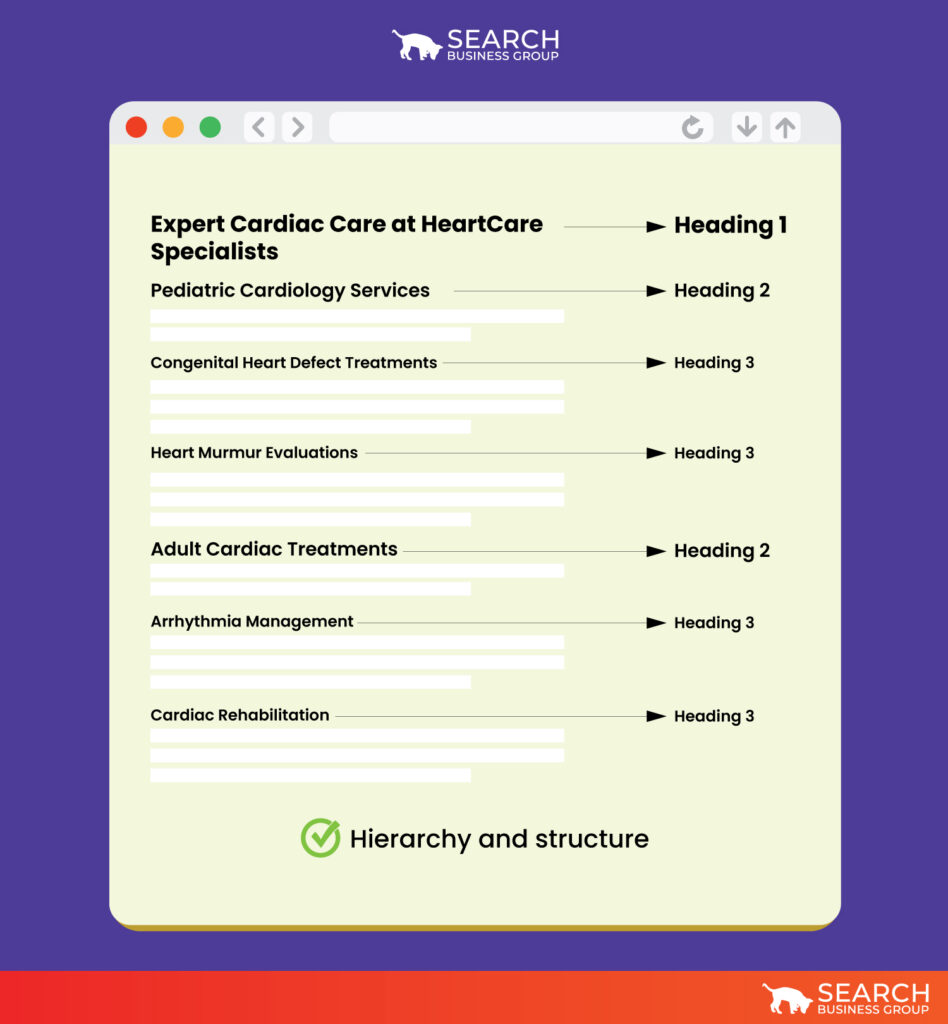Attention all healthcare professionals: Today, we will look at title tags as a critical but often overlooked aspect of healthcare marketing that emerges as a beacon of enhanced online presence and patient engagement. As medical professionals focus on patient care, diving into the intricacies of page titles might need to be clarified. However, understanding their role and optimizing them can significantly impact how patients discover your expertise and services online through search queries.
Demystifying Title Tags: What Are They?
Imagine title tags as the digital introductions of your healthcare website designs. These HTML elements, encased within <title> </title> tags, serve as the headline for your content in organic search engine results. They provide a glimpse into what your webpage offers, guiding search engines and patients.

The Role of Title Tags in Healthcare SEO: An Unseen Influence
SEO titles play a pivotal role in shaping your online presence, even if the intricacies of SEO are unfamiliar. Consider them as bridges between your medical insights and patients seeking them:
Healthcare SEO Rankings: While healthcare Search Engine Optimization might sound technical, its essence is simple—ensuring your valuable medical, high-quality content reaches the right audience. Page titles with strategically placed medical terms empower the Google search engine to connect patients with your expertise.
Empowering Patient Trust: In the healthcare industry, trust is paramount. A meticulously crafted title tag is a trusted guide, reassuring patients that your page contains accurate and authoritative information.
Navigational Beacons: Think of page titles as navigational signposts within the digital realm. Search engine bots use them to understand the context of your page, ensuring it reaches the right patients searching for answers.
Crafting Title Tags for Healthcare Providers: A Step-by-Step Approach
Creating effective title tags can be simplified into these steps, tailored for healthcare providers:
Precise Relevance: Align the title tag with the content it introduces. If your webpage offers insights into “Managing Diabetes Through Diet,” ensure your title tag reflects this succinctly.
Empathetic Keywords: Imagine the words a patient might type into a search engine when seeking advice. Incorporate those medical keywords into your title tag for enhanced discoverability.
Brevity for Clarity: Keep your title tag between 50-60 characters. This length ensures it’s fully displayed in search results, inviting patients to explore further.
Your Unique Identity: Each web page digitally reflects your medical expertise. Tailor each title tag uniquely to the content it accompanies.
Reassuring Branding: If your medical practice is well-recognized, including your brand name in the title tag can establish a sense of patient familiarity.
Inviting Language: Use action-oriented words like “Explore,” “Discover,” or “Learn More” to encourage patients to delve deeper into your content.
Increase the number of patients with healthcare marketing
Navigating Title Tag Mistakes: What You Should Avoid
Navigating the world of SEO titles requires steering clear of common mistakes:
Overloading with Jargon: While medical terminology is your domain, avoid overwhelming patients with excessive jargon. Aim for a balance between professionalism and patient-friendly language.
Promising the Right Content: Ensure your title tag delivers what it promises. Misleading patients with inaccurate content erodes trust.
Neglecting Localization: If your practice serves a specific region, incorporating location-based keywords ensures that local patients find you easily.
Elevating Patient Experience Through SEO Titles
In healthcare, patient experience is paramount. Crafting effective title tags contributes to this experience:
Answering Medical Queries: Patients often seek medical insights online. Well-optimized title tags guide them to accurate answers, building trust in your expertise.
Trust and Authenticity: As medical professionals, trust is your cornerstone. Your title tags become the initial touchpoints that showcase your authenticity.
Localized Care: Healthcare is personal and often location-specific. Using local keywords in title tags helps patients find your services nearby.
Is a Title Tag the Same as an SEO Headline?
A title tag and an SEO headline are distinct elements that complement each other. A title tag is an HTML component that specifies the title of a webpage, mainly visible in search engine results and browser tabs.
On the other hand, an SEO headline, often denoted by a <h1> tag, is the main heading within the content of a webpage, providing a clear structure for readers and search engines. While a title tag offers a concise preview of a webpage’s content, an SEO headline guides readers through the content itself.

Understanding the H (Heading) Titles: A Guide for Healthcare Providers
In content organization and readability, headings play a crucial role. In HTML, headings are marked by H1, H2, H3, and so on; the number signifies the level of importance and hierarchy. For healthcare providers venturing into the digital landscape, understanding these headings can enhance the structure and impact of your online content.
H1: The Main Heading
Think of the H1 tag as the title of a book—the primary and most significant heading. It introduces the main topic or subject of the page. Regarding SEO, search engines often interpret the H1 tag as a cue about the page’s core content. For healthcare websites, the H1 tag should reflect the central theme of the page, such as “Understanding ABA therapy” for an ABA therapy article on an ABA Therapy website design.
H2: Subheadings for Sections
H2 tags are like chapter titles in a book, providing subheadings for different content sections. They break down the main topic into smaller, manageable sections. In healthcare content, H2 tags could separate discussions about symptoms, treatments, and prevention strategies within an article about a specific medical condition.
H3: Drilling Down Further
H3 tags offer a deeper level of organization within H2 sections. They can be compared to sub-chapter titles in a book. For healthcare providers, H3 tags can segment information within H2 sections. For example, within the “Symptoms” section of an article about allergies, H3 tags might categorize symptoms into “Respiratory Symptoms” and “Skin Symptoms.”
H4 and Beyond: Nested Subsections
H4, H5, and subsequent heading levels continue the pattern of nested organization. They’re ideal for further breaking down complex information into manageable chunks. In healthcare content, these deeper heading levels could be used to elaborate on specific details, guidelines, or treatment options.
Using Headings Effectively
A well-structured content hierarchy not only enhances readability but also aids in SEO. Search engines recognize the organization of content through headings, making it easier for them to understand the context. When crafting healthcare articles, align your headings with the content’s flow and ensure they accurately represent each section’s information.
In summary, the various H titles—H1, H2, H3, and beyond—serve as an architectural framework for your content. They guide readers through your content, help search engines comprehend your topics, and enhance the user experience. As healthcare providers, utilizing headings can contribute to delivering impactful and organized online information to your patients.

How Page Titles Are Displayed: Your Online Calling Card
Page titles are seen in various contexts:
Search Engine Results: They appear as clickable links and provide users with an immediate understanding of your content.
Browser Tabs: When a user opens your page, the title tag is displayed in the tab, helping them identify your page among multiple tabs.
Social Media Shares: When your content is shared on social platforms, the title tag becomes the default title for the shared link.
Bookmarks and Favorites: Users see the title tag when they save your page for later reference.
External Websites: When other websites link to your content, the title tag previews your page’s topic.
Making the Most of Your Digital Presence: Beyond the Clinic Walls
Your digital presence extends beyond your physical practice. While seemingly technical, Title tags empower you to connect with patients profoundly. They allow you to impact lives beyond the confines of your clinic walls.
The Constant Evolution of Healthcare SEO: Stay Informed
As healthcare evolves, so do healthcare SEO tools. Stay updated with the latest trends, search engine algorithm changes, and patient behaviors. Adapting your title tags accordingly ensures you’re always meeting patients where they are.
In conclusion, the world of title tags holds the power to enhance your medical practice. By embracing these modest elements, you bridge the gap between your medical prowess and patients seeking guidance.
Are you looking for the help of medical marketing experts? Send us a message. We are ready to help you succeed!

